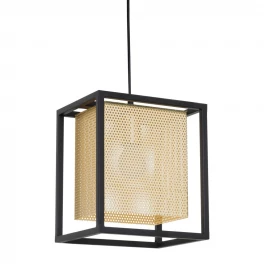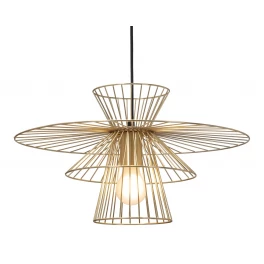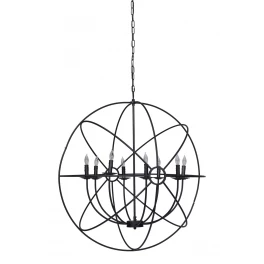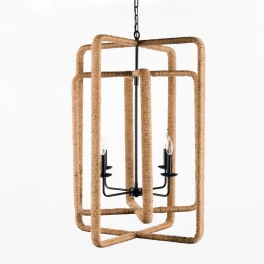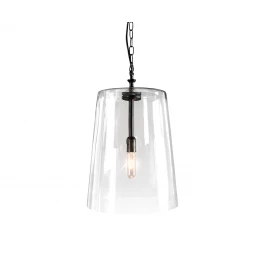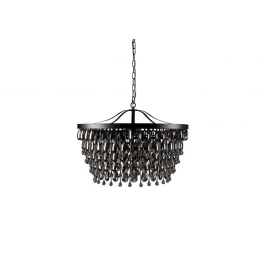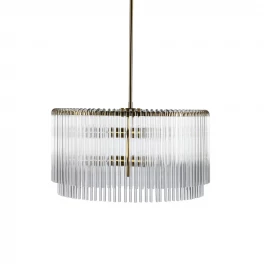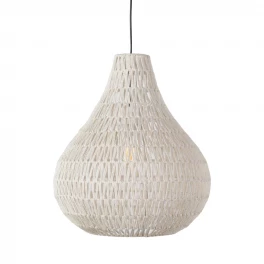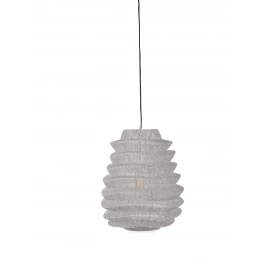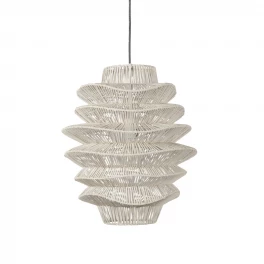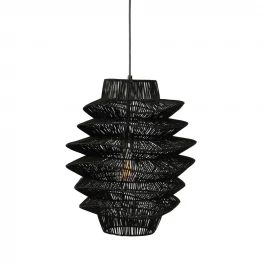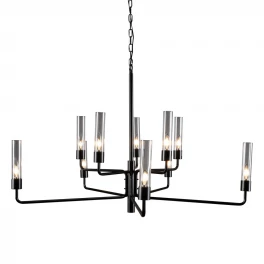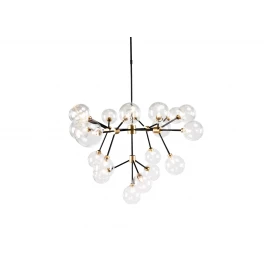Ceiling fans are commonly used appliances that can be installed in many different rooms. Essentially, the ceiling fan is a timeless classic in the realm of household appliances and can provide a subtle level of convenience and comfort. Since there are various models and units to choose from, you have to consider the cost of the unit itself and the installation of said unit.
There are dozens of factors that affect the cost of your ceiling fan, these factors will include the labor, the size of the fan, the type, the style, and the motors associated with the unit. You should keep in mind that there are other considerations to make when you set a budget for a ceiling fan installation. Typically, the cost will probably range between $350 to $650.
| Average Range | $350-$650 |
| Low-End | $250 |
| High-End | $1300 |
The low-end of the cost would probably be about $250, while the high-end of this estimate would probably amount to around $1300. One of the first few things to think about is the actual fan size and the area. Homeowners will try to purchase and install the ceiling fan to provide an enhancement in airflow and temperature control. You should think about what kind of ceiling fan will provide you with the proper preferences.
Table of Contents
- Ceiling Fan Installation Cost
- Ceiling Fan Price
- Size Of Ceiling Fan Costs
- Type Of Ceiling Fan Costs
- Ceiling Fan Materials & Costs
- Cost Based On Amount of Blades
- Benefits And Uses Of The Fan Blades
- Outdoor Ceiling Fan Cost By Moisture Rating
- Downrod Installation Cost
- Ceiling Fan Cost By Style
- Labor Cost For Ceiling Fan Installation
- Ceiling Fan Mounting Box Cost
- Ceiling Fan Electrical Box Cost
- Ceiling Fan Replacement Cost
- Ceiling Fan Maintenance Cost
- Ceiling Fans Vs Air Conditioning Comparison Costs
- Finding Multiple Estimates Through House Tipster
Ceiling Fan Installation Cost
Before you can even begin taking on this project, you have to think about whether you need a fan for an outdoor space or an indoor space. One part of the consideration will go towards moisture and how the fan will adapt to the amount of humidity in that particular space. Homeowners need to understand that indoor and outdoor fans are rated by the measurement of dryness and dampness. An indoor fan will not work in an outdoor setting since the rating is dry-based.
The cost of the indoor ceiling fans can range between $200 to $800, while the cost of the outdoor ceiling fans can range from $300 to $900 or more. The major difference of the two types and models is the construction material. Once the model is considered, the manufacturer will find out whether the blades need to be coated with plastic or constructed with plastic or stainless steel options.
| Indoor | $200-$800 |
| Outdoor | $300-$900 |
Ceiling Fan Price
The simplest method to finding your ceiling fan’s cost is by determining the size of the blades and the components of the fan. Homeowners will finalize the measurements of the fans basing it on: the actual span of the blade or the diameter range of the blades while the fans rotate. Determined by the amount of blades on the fan, the measurements will be noted by either the odd or the even number of blades.
With an even amount of blades, homeowners can measure the tip end of one blade to the tip end of the blade opposite. An odd number of blades can be measured from one tip end of the blade to the center of the fan, multiplying the measurement by two to determine the whole diameter.
Another factor to consider is the design choice of the ceiling fan. Depending on the type of fan it is, the cost of the ceiling fan will vary. Since each of the different types of ceiling fans were designed to meet a particular standard, homeowners need to think about which spaces are best suited for these individual styles..
Size Of Ceiling Fan Costs
Essentially, if the size of your fan doesn’t match the size of the room you’re trying to install the ceiling fan, you may have complications for the project down the line. Difficulties that you will have to face is the risk of the fan breaking apart and damaging the rest of your spaces.
| Small | 29-36 | 75 or less | $50-$300 |
| Mid | 36-44 | 76-144 sq ft | $50-$500 |
| Moderately Large | 44-54 | 145-225 sq ft | $70-$600 |
| Large | 50-72 | 226-400 sq ft | $65-$650 |
Type Of Ceiling Fan Costs
Although the type of ceiling fan may not appear as significant as the size, your professional will have trouble if the unit isn’t specifically designed for the spaces you’re trying to install it in. The contractor will evaluate whether the model of the fan is meant for the ceiling or any other suggested area.
| Standard | $50-$300 |
| Low-Profile | $50-$300 |
| Hanging Propeller | $150-$550 |
| Directional | $150-$800 |
| Rotational | $200-$1500 |
Standard
A standard ceiling fan is common around most households. It’s the oldest design and unit in the market and will cost between $50 to $300. These are the fan models that point downward from where it’s installed, the blades rotating adjacent to the ceiling space. The standard ceiling fan will likely be built with five blades and will have a fixture installation. Homeowners should think about what kind of features and upgrades they can have included with the installation of the standard ceiling fan.
Low-Profile
A low-profile ceiling fan is estimated to cost about $50 to $300, about the same estimated range as the standard ceiling fan. It is referred to as the flush mount or hugger fan due to the distance between the fan and the ceiling. These units are practical for ceilings that are about eight feet high or lower. Highly suited for smaller spaces, the low-profile ceiling fan is typically installed in places that are small. Even if such a small area had taller ceilings, this unit will circulate air efficiently.
Hanging Propeller
Ranging between $150 to $550, the hanging propeller model will be installed with an extended pole that reaches from the base of the fan. Keep in mind that this fan unit will hang lower than the other units mentioned in this section. The best advantage that the hanging propellers have to offer is the temperature control that maintains both heat and cold, according to the direction of the spinning blades.
Directional
Estimates for installing the directional fan ranges between $150 and $800. It is the convenience of having air directed in whichever way you most desire. Designed to traffic airflow in one direction or the other, the installation of the directional ceiling fan is meant to be inverted with a downrod.
Rotational
The rotational ceiling fan unit will probably range from $200 to $1500. Typically, this fan is designed with directional fans attached with dual heads rotating on an axis. Homeowners that want to maintain the modern look but want to add a ceiling fan to their space will generally opt for the rotational fan. Larger rooms benefit from the rotational fan since they are designed and constructed with dual motors.

Ceiling Fan Materials & Costs
Other than the size and type of the ceiling fans, homeowners will have to think about what kind of materials will go into manufacturing the blades. Depending on the usage of the ceiling fan, homeowners will have to think about which materials will be most applicable to the rooms you’re considering. Homeowners should carefully consider all their options since the option might help lower the cost of installation.
Depending on the noise level, homeowners may want to rethink the options before them. Although they may be louder, the metal blades will circulate air that much more efficiently. Metal is beneficial for those reasons, however, there is a major difference between aluminum and steel. While the advantages of the materials can determine the overall result of airflow circulation, you should think about what else may be regarded into the whole project.
| MDF | $45-$450 |
| Plastic | $50-$200 |
| Aluminum | $60-$400 |
| Steel | $70-$1500 |
| Palm Leaves | $100-$450 |
| Wood | $100-$1400 |
It is precisely why homeowners will choose to install an MDF or Medium Density Fiberboard ceiling fan, since there is the minority of homeowners that feel uncomfortable with steel or plastic. There are some concerns with some of these materials. Wood fans can warp from temperature fluctuations, but can be quite durable in terms of construction.
Cost Based On Amount of Blades
The cost of installing ceiling fans, as mentioned above, can be estimated by the number of blades that the unit will come with. Homeowners typically decide on the amount of blades according to the aesthetic that they’re trying to match. The appeal of the space is often arranged by the visual enhancement provided by the number of fans.
Essentially, two bladed fans will offer a more modern look to your rooms, while the five bladed fans will offer a rustic approach to the appearance. Two-blade fans are most suitable for ornamental purposes and will be available as a premium designer option. Fewer blades are pragmatic for smaller spaces, so keep in mind that two and three-bladed fans will make much more noise than five-bladed fans.
| Blades | Cost Range |
| 2 | $150-$500 |
| 3 | $100-$600 |
| 4 | $100-$700 |
| 5 | $75-$700 |
| 6 | $200-$700 |
Benefits And Uses Of The Fan Blades
Summer is always around the corner, and with the warm signs of spring in effect, you may want to consider making the right changes to your fans. Since they’re an effective alternative in air circulation, ceiling fans have become a mainstay with households that are wary about the costs of air conditioning.
Three Blade Ceiling Fans
If you’re looking for a commonplace installation, you should consider installing the three-blade ceiling fan. With a dynamic blade balance, the three blade ceiling fans typically operate with high speeds using fewer components and won’t need a minimum of energy. However, the only disadvantage to the three blade ceiling fans is how much noise they make.
Four Blade Ceiling Fans
Rather than the three blade ceiling fans, homeowners can install the four blade ceiling fan instead. They won’t produce as much noise and are better equipped in rooms with an air-conditioning unit, which disseminates cool air much more efficiently. Typically, the four blade offers a better aesthetic.
Five Blade Ceiling Fans
There is no major difference between the five blade and the four blade ceiling fans. However, the rule to ceiling fans is the noise factor. If a ceiling fan has more blades on it, odds are, it won’t produce as much noise. Homeowners will install a five blade ceiling fan to make it an optimal utility for appearance and air circulation.
Outdoor Ceiling Fan Cost By Moisture Rating
If the project you’re planning to execute isn’t focused on the indoor aspect and you’re thinking about installing a fan into an outdoor area, you’ll have to think about the motor types and other structural materials. But the most crucial aspect of these components is their durability against the weather. Typically, there are three rating types that will determine the prices.
| Dry | $100-$1000 |
| Damp | $125-$1100 |
| Wet | $150-$1200 |
Dry Rating
Ceiling fans that are dry-rated will cost about $100 to $1100. Designed specifically for indoor living spaces that have limited exposure to moisture, the dry-rated fan is meant for bedrooms, dining rooms, workshops, finished basements, and foyers. Homeowners can also use dry-rated ceiling fans with spaces that provide sufficient ventilation.
Damp Rating
A damp-rated ceiling fan is a highly capable application for outdoor settings. Installing one will cost you about $125 to $1100, and the advantages include resistance from high humidity and areas with excess moisture. One of the key indicators of whether you can use a damp-rated ceiling fan is whether you have climate control of the applied area. Circulation is also applicable for settings like the bathroom or the laundry room.
Wet Rating
A wet-rated ceiling fan will cost approximately $150 to $1200. It is probably one of the most convertible ceiling fans out of this list. These sorts of fans operate under any of the disconcerting conditions that may be deemed contrary. Those conditions include rain, snow, and wind. Since every component of the fan is waterproofed by design, you won’t have to feel distressed from using the wet-rated ceiling fan outdoors.
Downrod Installation Cost
As briefly stated above, the downrod is the extended attachment that can be installed with your ceiling fan. Typically, the estimate of installation will range between $3 to $100, depending on the height of your downrod.
Why should I have a downrod installed to my ceiling fan?
- Stabilize the fan and prevent it from wobbling in place
- Adequate air circulation and flow comes from the precise height that it is meant to be installed
- Maintain safe enough distance between the blades and the ceiling
- Maintain safe enough distance between the fan and the floor
| 9 ft | 6 inches | $3-$20 |
| 10 ft | 12 inches | $6-$85 |
| 12 ft | 24 inches | $11-$75 |
| 14 ft | 36 inches | $10-$75 |
| 16 ft | 48 inches | $25-$100 |
| 18 ft | 60 inches | $30-$100 |
| 20 ft | 72 inches | $35-$110 |
Ceiling Fan Cost By Style
Style is one of the best indicators which will affect the overall pricing of your ceiling fan. The design choice is only limited by your sense of preference and practicality. Limited only by the boundaries of creativity, the ceiling fan will come in an endless array of design efforts. One of the most popularized products out of the inventory to choose from is the modern style. Essentially, it is the design that features metal, either in construction or coating.
Related to the modern style is the industrial style, a route in the minimalistic standards, and while it is a popular option amongst the other design options, there are designs that are suited to homeowners that favor traditional or contemporary tastes.
Matching the styles of your ceiling fan to the styles of your space is an essential part of installing your unit. The older your home seems, the more likely you’ll lean towards rustic or traditional accent pieces. However, the most suitable aesthetics to look for, in regards to these types of fans, is a wooden themed surrounding. If your kitchen has more of the wooden decor, it’s best to browse through the rustic or farmhouse options.
| Average Styles | Cost Range |
| Modern | $40-$2000 |
| Industrial | $50-$500 |
| Traditional | $50-$900 |
| Rustic | $50-$1200 |
| Contemporary | $50-$1250 |
| Mission | $100-$700 |
Modern
The modern ceiling fan will cost anywhere from $40 to $2000. Typically, the modern fan consists of three blades, which will come in a variety of designs. Although the modern design is common, homeowners should carefully consider which unit to install since there are many different kinds of modern fans out in the market.
Industrial
The larger ceiling fans are often referred to as industrial fans. Installing them will cost about $50 to $500. These fans are typically manufactured with materials like steel, aluminum, and industrial-grade plastic. By constructing the fans with durable materials, your home will have a stronger circulation of air flow. Keep in mind that the size of the industrial-style fans are generally larger than the average modern fans.
Traditional
A traditional ceiling fan will have a more classic appeal compared to the more modern approach. The traditional fan will range between $50 to $900. Most of the traditional style ceiling fans will include venting, straight sides, and standard blades, adding versatility. The installation of a traditional ceiling fan can be emphasized through accent lights.
Rustic
Ranging between $50 to $1200, the rustic ceiling fan is a multi-faceted application that can work throughout your indoor and outdoor spaces. The more farmhouse style of the fans will come in distinct finishes. The selection of these finishes include oil-rubbed bronze, brushed nickel, matte black, distressed koa, noble bronze and even natural finishes such as oak or walnut.
Contemporary
Much like the modern ceiling fan, the contemporary ceiling fan will have the most common styles of ceiling fans. However, the contemporary might have more blades involved and will cost approximately $50 to $1250.
Mission
This ceiling fan is designed to express the original inspiration of the American Arts and Crafts movement. Alongside geometric design, the mission style ceiling fan will also include natural finishes and art glass. You’ll have to spend about $100 to $700 to have a mission ceiling fan installed.
| High-End Styles | Cost Range |
| Victorian | $100-$2200 |
| Windmill | $100-$1500 |
| Tropical | $150-$1850 |
| Lantern | $150-$3000 |
| Fandelier | $230-$2000 |
Victorian
A style that prioritizes design and ornamental value most, the Victorian ceiling fan will cost between $100 and $2200. This kind of Victorian design can match the traditional or farmhouse aesthetic and it has all the functionality of the other styles.
Windmill
Although it rotates slowly, the windmill ceiling fan moves a lot more air than the ones mentioned above. Installing the windmill ceiling fan will probably cost you about $100 to $1500. Even if the windmill ceiling fan may not actually generate cool air, it can create a wind chill effect. Unlike the conventional air circulation that occurs with a standard ceiling fan, the windmill ceiling fan uses heavier blades to maximize the amount of airflow moving around the room.
Tropical
The tropical ceiling fan will cost you about $150 to $1850. Like the Victorian, the tropical ceiling fan will solely incur an ornamental aspect into your home. Mirroring the tropics and island living, there are several options to change the blades. This includes palm leaves, rattan fans, wicker, and bamboo accessories.
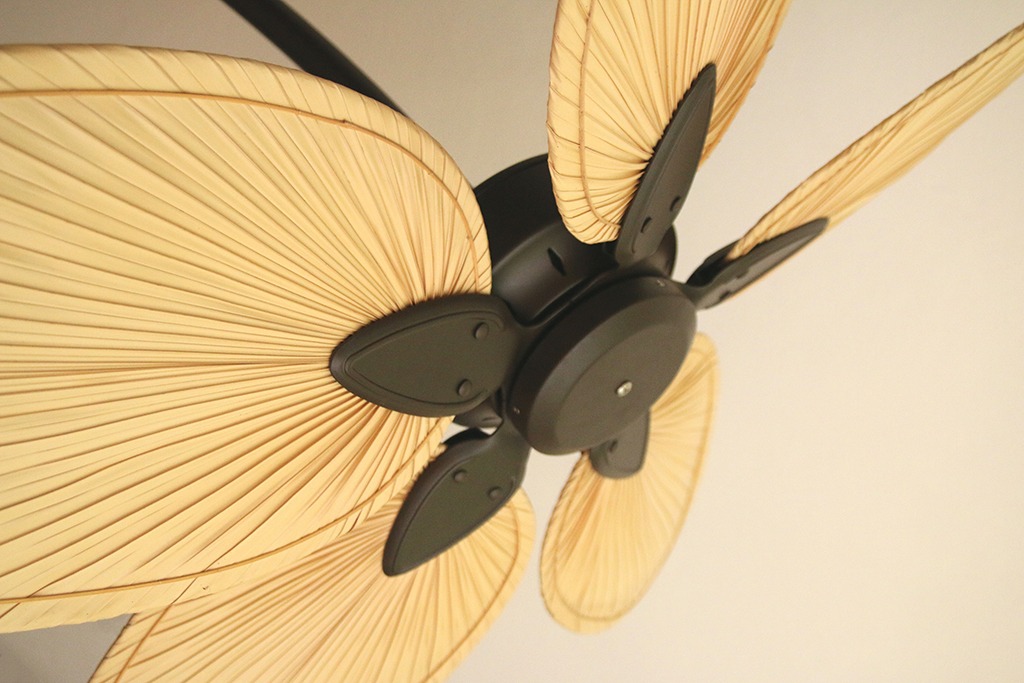
Lantern
An increasingly popular choice amongst homeowners, the lantern ceiling fan is a great choice to install into your home. Costing about $150 to $3000, the installation for this type of fan is focused on entryways, patios, and porches. It holds both aesthetically pleasing qualities and pragmatic capabilities.
Fandelier
Although originally a play on words, the fandelier has become a fine ornamental option for homeowners that prefer the high-end pieces. Installation is estimated to cost about $230 to $2000. The elegance that the fandelier exudes is unmatched from the other options available in the market.
Labor Cost For Ceiling Fan Installation
There are different jobs associated with a project of this scale. Labor costs will be determined by the kind of labor that will go into the installation, depending on the prep work done for the space the fan is supposed to be installed. Although the material costs might be mentioned above, the professional work that is being done will have different costs according to the space itself and the upgrades you want to implement into your project.
The pricing for this project could be estimated to be as low as $40 and can be driven all the way up to $3000. Jobs like electrical work will probably range between $60 to $320, depending on the simplicity or the complexity of the project. Some of the aspects that will alter the cost range are the features you want included in the ceiling fan.
Typically, the cost range for installing a ceiling fan indoors will likely be between $60 and $250, while installing a ceiling fan outdoors will cost about $150 to $320. The reason why the outdoor costs are a little higher is due to the extended electrical work that needs to be done within the house and materials for waterproofing the area. Contractors and electricians will likely cost about $60 to $90 per hour for the installation to be completed.
Some scenarios that could affect the cost are situations where homeowners simply wish to renovate their fans, removing the old fans to install the new ones. If this is the case then you won’t have to spend additional wages for the installation of new wiring. Installing a new ceiling fan in the same location would certainly cut out time.
Cost of Installing Ceiling Fan With Old Wiring
Contacting and hiring a professional to come to your home and install a ceiling fan with your old wires will probably cost about $60 to $150. The advantage of installing a ceiling fan in a former locale is that the job will only last about an hour to finish. If you’re thinking of choosing a lower-end unit, the overall installation cost should only range between $350 to $650.
Cost of Installing Ceiling Fan With New Wiring
Homeowners that have a new area they want to install a ceiling fan will have to consider the wiring that is included in the project. There is a time constraint that occurs when installing these components throughout your home. With the arrangement of the parts, whether it’s the inclusion of some switches or joists, there is the concern of placing a power switch in the surrounding area and a power box nearby.
You’ll have to spend about $280 to $320 due to the time that it takes to complete all of the work associated with that sort of project. Homeowners should keep in mind that the estimated average is likely going to be higher due to the number of professionals in different fields you’re going to need for the project.
Ceiling Fan Mounting Box Cost
Besides the wiring and all of the other components into installing the ceiling fan, you’re going to want to consider the fact that this is a 50 pound unit. Using a strong mount to hold it into place and keep it from collapsing or falling apart, you’ll want to think about purchasing and setting up a mounting box to keep in a supported position. The fan mount will probably only cost you a range between $8 to $15. If you’re replacing the fan, then you’re going to want to have your specialist handle the job since your fan may become loose over time.
Ceiling Fan Electrical Box Cost
Although homeowners may believe that an electrical box is unnecessary, there are advantages to installing one. In some cases, homeowners will exceed the 80 percent limit which could damage your circuit breakers. The installation will probably cost you around $250 to $400 for another breaker to be installed, but a replacement will cost you an estimated range of around $900 to $1300. An initial installation may be a worthier investment than having to arrange a replacement.
Ceiling Fan Replacement Cost
Typically, the rate of the labor for a ceiling fan replacement will remain the same. Homeowners should expect to spend about $60 to $90 on an hourly basis. Like all appliances and utilities, eventually, that old ceiling fan that you had for a while will probably need to be replaced. In a way, discoloration or deterioration could be reason enough to have a new fan installed. The cost of having the ceiling fan repaired might cost a range between $90 to $200 instead of having to reinstall everything.
Ceiling Fan Maintenance Cost
To keep your ceiling fan maintained in good condition, you’re going to want to examine the standard parts. Homeowners should carefully examine if the blades are completely secure and to do so, you must also scan through the smaller components and whether they’re tightly screwed in. Unfortunately, if the fan isn’t properly installed or isn’t maintained in a well-enough condition, you’ll have to pay for additional costs that will come out of your pockets.
Ceiling Fans Vs Air Conditioning Comparison Costs
Although both appliances are meant for cooling your home, you may want to rethink all the costs that are involved with both your ceiling fan and your air conditioner. The air conditioner is a specific type of unit that works well with a centralized and optimized space. Within the realm of pricing, ceiling fans are a more affordable option.
The operations of an air conditioning unit would probably be what you’re looking for if you want something more effective with cooler air. However, for applications involving the outdoors, the ceiling fan might be your only option to cool your backyard or front porch. Keep in mind that an air conditioning unit will increase the costs of keeping it operational.
Ceiling Fan Features & Upgrades
There are additional features that you can include into your ceiling fan. There are cost ranges that you’ll have to deal with if there are additional needs you wish to address with your professional. Often the ceiling fan will have the schematics include light fixtures, however, there is a small chance that the lights aren’t included with the unit you’re looking for. Keep in mind that the ceiling fans that are meant for outdoor applications will probably have fixtures.
A ceiling fan with a remote will cost you about $70 to $1100. You won’t have to deal with purchasing and installing a new fan since there are remote control kits that will only cost about $20 to $100. This kind of job will only take an hour to set up and will likely cost about $75 for the professional to complete, however, if you don’t have the right electrical work procured, an electrician will finish the process, costing you about $120.
Finding Multiple Estimates Through House Tipster
A project involving ceiling fans may require more than a handful of professionals to help homeowners with their projects. Finding the right people for the project, whether it is for a replacement, repair, or installation, can be a tough process. By using House Tipster, you can effectively get rid of any of the concerns associated with this tedious effort.
There are two main functions that will make your life that much easier. Our web tool uses a chat function and a reviews function to allow our users to find their perfect professional through our listings. By using the chat function, users will have the ability to communicate with the professionals directly.
Our reviews function is also the perfect way to confirm that this is the professional you’re going to work with. Home improvement requires the right standard of a specialist. One of the most effective ways to give your home the improvement it needs is finding the right kind of expert to install everything correctly. With our reviews feature, you can easily browse through the work that the business has done in the past with former clients. After you peruse the reviews left by previous clients, you’ll easily be able to tell which listing is the most preferable.
Featured Photo By Alvin Matthews On Unsplash




